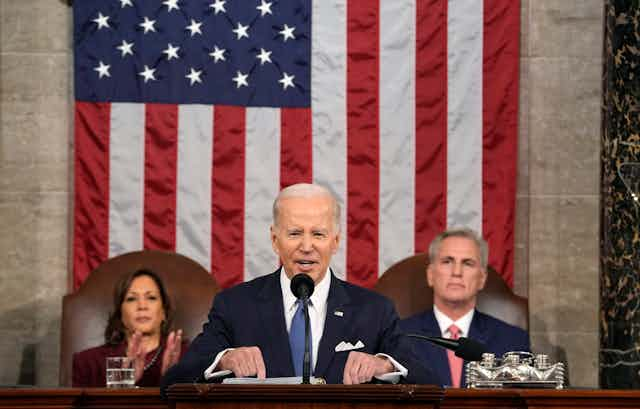The US president Joe Biden delivered his second State of the Union address with a message of optimism, declaring – as is customary – that “the state of the union is strong”. With newly elected Republican speaker Kevin McCarthy and Democrat vice-president Kamala Harris sat behind him, Biden launched what commentators described as his bid to win the 2024 presidential election.
Biden used his 70-minute address to talk up the achievements of his first two years in office, hailing America’s falling inflation and rapidly growing job market – described by one report as “shockingly strong”. In front of a divided Congress, after the GOP won control of the House in last year’s midterms, he laid out his legislative and policy objectives. But the mantra for the evening was: “Let’s finish the job” – a phrase he used a dozen times in his speech.
It is the first time that Biden has had an opportunity to drive this message home to a national audience.
“As I stand here tonight,” he said, “we have created a record 12 million new jobs – more jobs created in two years than any president has ever created in four years.”
Although inflation remains stubbornly high, Biden has spent a great deal of time advertising the success of his bipartisan infrastructure bill around the country. This occasion was no different, stating that his administration had “funded over 20,000 projects across America” to build “the best infrastructure in the world”.
Biden began his speech by congratulating McCarthy on his election to speaker – “Mr Speaker, I look forward to working together” – before repeatedly stressing the need to reach across the political divide, citing that in the previous two years he had signed “over 300 acts” into law that were bipartisan in nature.
“We have to see each other not as enemies, but as fellow Americans,” Biden told the assembled crowd.
He called on Republicans to address the issue of the debt ceiling to avoid defaulting on its debt obligations, something that treasury secretary Janet Yellen has called a potential “economic and financial catastrophe”.
Criticising “some” Republicans who he said “want to sunset Medicare and social security every five years”, Biden pledged to prevent them from doing this, and then – in a nod to the bipartisan style he had adopted – ad-libbed that he knew the majority of the GOP agreed with him.
Calling for a higher rate of taxes for major US corporations, Biden said: “The tax system is simply unfair” – much to the delight of progressives in his own party.
And with the parents of Tyre Nichols – who died recently after being pulled over and apparently beaten by traffic police in Memphis, Tennessee, in an incident caught on video camera – watching from the gallery, Biden called for police reform and a ban on assault weapons. “We have an obligation to make all people safe,” he said.
But in the Republican-controlled House, many of his more progressive demands are likely to fall on deaf ears. While acknowledging this, Biden stressed that if conservatives think they can pass any legislation during this Congress that makes abortion illegal, “I will veto it.” He called on Congress to codify reproductive rights.
Eyes on 2024
As had been widely predicted, Biden’s speech was clearly the unofficial launchpad for his bid for a second term in office. It would be no surprise to see “Let’s finish the job!” as the tagline for his 2024 campaign.
But despite this speech, several things stand against him being returned to the White House in 2024.

Firstly, the majority of Americans feel that, despite their president’s assertion,the state of the union is not to be celebrated. Recent polls reveal that the public are yet to be convinced by Biden’s handling of the war in Ukraine, the economy, and even his ability to unite the nation.
His handling of the recent spy balloon saga has also led to severe criticism for doing “too little, too late”. A poll taken on February 5 showed that 62% of Americans would be “angry” or “dissatisfied” if he were elected again.
One of the biggest issues remains his age. Should Biden be successful in the 2024 election, he will be 82 when he begins his second term – the oldest US president to be elected to office. Another recent poll revealed that only 28% rate him positively on “having the necessary mental and physical health to be president”.
But while his age may be against him, time might be on Biden’s side. By November 2024, the economy could well be in recovery. Inflation fell in December for the first time since the beginning of the pandemic, and the administration hopes this trend will continue over the next 18 months.
Brian Deese, Biden’s chief economic adviser, told reporters this week that he felt that as far as the administration’s major economic bills were concerned, “2023 is the year in which the most significant impact will begin to occur”.
And while Biden’s polls are not the best, they are certainly better than the Republicans’. Polls reveal that Americans currently have little confidence that Republican leaders would fare much better.
The road to the White House is a marathon not a sprint, but Biden has clearly put himself into the race. His first steps on that journey will take place in Wisconsin on Wednesday, where he won narrowly in 2020. He is expected to confirm his re-election bid at a rally there to discuss his economic plan, before heading to Florida the following day to talk about Medicare and social security.

